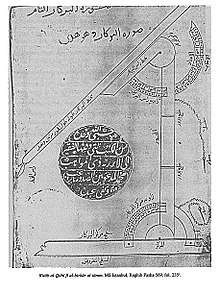Ibrahim ibn Sinan
Ibrahim ibn Sinan (Ibrāhīm ibn Sinān ibn Thābit ibn Qurra, ابراهيم بن سنان بن ثابت بن قرة; born 295-296 AH/908 AD in Baghdad, died: 334-335 AH/946 AD in Baghdad, aged 38) was an Arab[1][2] Muslim scholar from Harran in northern Mesopotamia/Assyria, the grandson of Thābit ibn Qurra.[3] He was mathematician and astronomer who studied geometry and in particular tangents to circles.[1][3] He also made advances in the quadrature of the parabola and the theory of integration, generalizing the work of Archimedes, which was unavailable at the time.[1][3] He is often referenced as one of the most important mathematicians of his time.[1]
Ibrahim ibn Sinan | |
|---|---|
| Born | 908 |
| Died | 946 (aged 38) |
| Occupation | Astronomer, mathematician |
| Era | Medieval |
| Parent(s) |
|
See also
- List of Arab scientists and scholars.
Notes
- O'Connor, John J.; Robertson, Edmund F., "Ibrahim ibn Sinan ibn Thabit ibn Qurra", MacTutor History of Mathematics archive, University of St Andrews.
- Schlager, Neil; Lauer, Josh (2001). Science and Its Times: 700-1449. Gale Group. ISBN 9780787639341.
- Van Brummelen, Glen (2007). "Ibrāhīm ibn Sinān ibn Thābit ibn Qurra". In Thomas Hockey; et al. (eds.). The Biographical Encyclopedia of Astronomers. New York: Springer. p. 574. ISBN 978-0-387-31022-0. (PDF version)
Further reading
- Rashed, Roshdi (1996). Les Mathématiques Infinitésimales du IXe au XIe Siècle 1: Fondateurs et commentateurs: Banū Mūsā, Ibn Qurra, Ibn Sīnān, al-Khāzin, al-Qūhī, Ibn al-Samḥ, Ibn Hūd. London. Reviews: Seyyed Hossein Nasr (1998) in Isis 89 (1) pp. 112-113; Charles Burnett (1998) in Bulletin of the School of Oriental and African Studies, University of London 61 (2) p. 406.
- Rashed, Roshdi (2008) [1970-80]. "Ibrahim Ibn Sinan". Complete Dictionary of Scientific Biography. Encyclopedia.com.
This article is issued from Wikipedia. The text is licensed under Creative Commons - Attribution - Sharealike. Additional terms may apply for the media files.
